Reduced to its quintessential form, the question most frequently asked concerning Baroque concerts and recordings over the past twenty-five years would be as follows: "How does one manage to impart an easy and natural flow to the music, so that the meter, structure, and phrasing of the poetry comes through clearly? Is it something to do with the tempo one chooses?" Tempo has little to do with the matter: the secret (if such there be) lies in the accurate perception of verbal stresses and rhythms, the unequivocal disclosure of these in the preparation of a practical edition, and then the normal procedure of rehearsal and performance. Many years ago, as a BBC producer, I learned from that incomparable artist Sir Thomas Beecham that zest and meaning in a performance did not derive from a rushed or rapid tempo, but from a careful placing of accents. Much early music, I am sorry to say, is driven along at impossibly fast tempi, with the result that the words are almost incomprehensible. I recall one recorded version of Filles à marier, by Gilles Binchois, which jets to an untimely end in 25 seconds, whereupon the musicians repeat it immediately in order to ensure its being visible on the disc.
This is no way to serve the cause of poetry or its musical settings. Nor will it help very much to thrust upon true polyphony the kind of irregular barring with which Leichtentritt, Gombosi, and others liked to experiment. Music of the prima prattica looks after itself very well for the most part, though it is still necessary to be watchful when—even for a brief period—homophony takes over and demands a sensible projection of the text. The same is also true in certain examples of polyphonically animated homophony, such as the extract from Stoltzer's Erzürne dich nicht given in Ex. 1, cited in an excellent but little-known article on "Editionstechnik" by Hans Albrecht (MGG 3, cols. 1109-1146).
Ex. 1. "Das Gèsetz seinès Gottès"
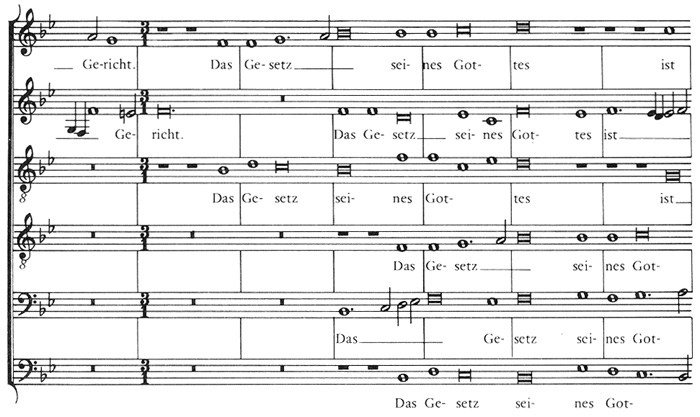
Quite obviously the verbal stresses should be aided by musical ones, but in Ex. 1 the word "Gesetz" receives false accentuation. Furthermore, the underlay of text to music is unsuitable and inconsistent here and there: for there does exist such a concept as verbal homophony, in which words and syllables call for correct alignment in more than one voice-part (see especially the phrase "seines Gottes"). In fact Albrecht reminds us (col. 1124) that there are three very good reasons for improving on the way in which original texts were underlaid to notes—the scribes and printers were often inexact, they used repetition signs that frequently left matters entirely to the performer, and therefore a modern practical edition should try to solve some of these problems for the benefit of would-be interpreters. One possible revision of Ex. 1 is given in Ex. 2.
Ex. 2. "Das Gesètz seines Gòttes"
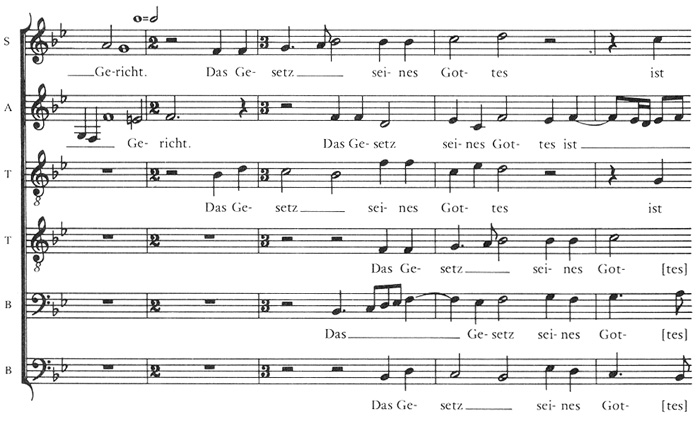
By way of introducing his bibliography, Albrecht remarks that the technique of editing early music has but rarely been dealt with as a major topic, as it deserves to be; and although he wrote those words a quarter of a century ago they still hold true, by and large.1 A comprehensive study of editing still awaits its champion. And only when the editions are right will the performances attain those heights expected of them. Part of the trouble may be traced to the musical training of musicologists (for it is they who usually do the editing), since it will be found that in the great majority of cases their background is in instrumental, not vocal music; and in consequence they have never acquired the habit of singing through what they transcribe in order to make sure that it works from a practical point of view. It is not good enough to leave questions of text-underlay to the choir director, for he has no time to study Giovanni del Lago, Kaspar Stocker, or Gioseffo Zarlino, let alone cope with the obscurities of musica ficta. Sometimes musicologists manage to confuse themselves by their own transcriptions. The redoubtable editor of Giovanni Gabrieli,2 citing a passage from the 8-part motet Jubilate Deo (1597), refers to the composer's "predilection for off-beat accents" (Ex. 3)—
Ex. 3. "in èxultàtionè . . ."
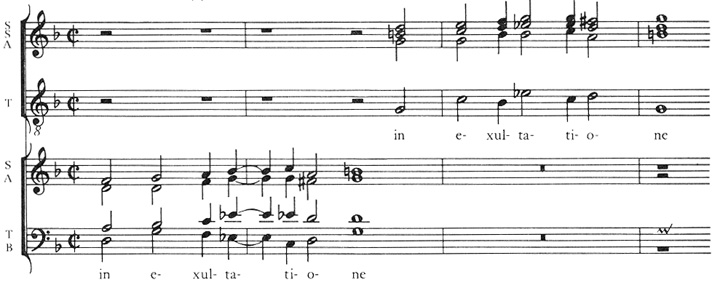
—when what he really means is a simple hemiola pattern, which was one of the most characteristic of Renaissance rhythmical turns, as is revealed in Ex. 4:
Ex. 4. "in èxultàtiòne . . ."
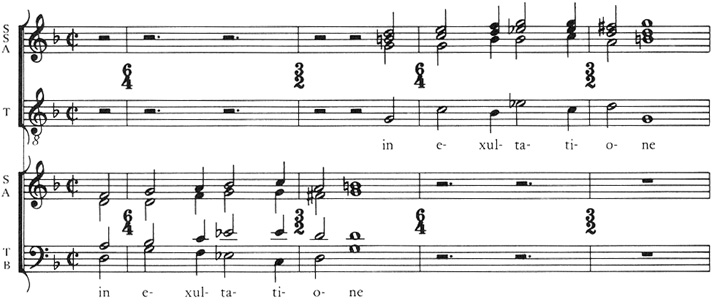
These features, then, call for watchfulness in dealing with music of the prima prattica, and in like manner there are constantly recurring stylistic features in sacred and secular music of the seconda prattica that demand our attention. One of the most important of these may be seen even from the most rapid glance at a vocal work influenced by the speech-rhythms favored by Giaches de Wert, Benedetto Pallavicino, and the young Monteverdi. All three were involved in a pre-operatic venture whose impact has yet to be properly assessed in the history of dramatic music—the early productions of Guarini's Pastor fido in north Italian cities during the last decade of the sixteenth century. One of the principal aims of these composers was to allow the poetry to be heard clearly by the audience, and to this end they adopted a new technique of composition in which homophonic writing played a preponderant role. Yet when these works are barred in the usual manner, with one whole note to a measure, the speech-rhythms that the composers were so anxious to project suffer from instant suffocation—so much so that in certain extant recordings one can hear the chorus singing the bar-lines instead of the verbal accents proper to the language.
In many cases all that needs to be done is to bring about a simple displacement of printed bar-lines, so that the false declamation of Ex. 5a (from Pallavicino's Cruda Amarilli, Book VI à 5) becomes sensible and correct as in Ex. 5b:
Ex. 5.

All voices at that juncture are singing in the same rhythm as the soprano part quoted, except at the cadence; and the same is true of the next two examples. Aside from simple displacement of bar-lines in duple time, the most frequent feature calling for recognition is the hidden tripla section, usually noticeable as a macro-rhythm  or
or  as in this extract from another Pallavicino-Guarini madrigal (though not a part of Pastor fido), published in Book VI à 5:
as in this extract from another Pallavicino-Guarini madrigal (though not a part of Pastor fido), published in Book VI à 5:
Ex. 6.

The tell-tale tie over a bar-line ought to lead the reader's eye immediately to the source of trouble, and once this ability to recognize such situations has been developed fully, the problem of faulty accentuation will be banished. This example, from Marenzio's Book VII à 5, is similar to the previous extract:
Ex. 7.

A macro-tripla involving a hemiola shift can be seen in this madrigal by Gesualdo, Che fai meco, from his Book IV à 5 (Ex. 8a, b):
Ex. 8a.
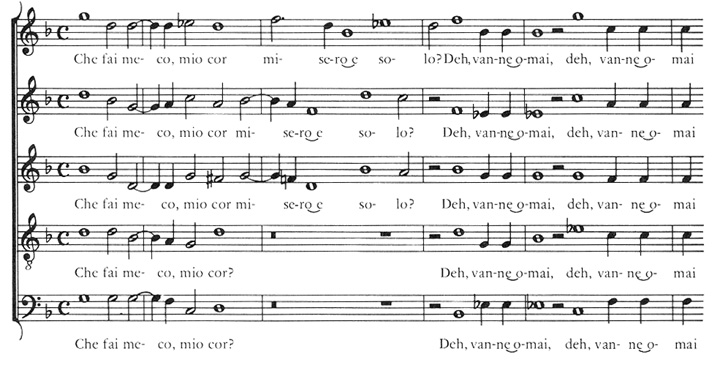
Ex. 8b.

To bar or not to bar, that is the question. Ever since musical scholars began their self-appointed and apparently ceaseless task of making the repertoire of earlier times available in brand-new editions, discussions ranging from the argumentative to the dialectical have continued to enliven the musicological scene and to generate—by theory out of practice—countless novel methods of transcription. These can be found and studied in the serried ranks of scholarly volumes on the one hand, while on the other we have a more humble counterpart, ranging from the practical performing edition to the edition that is practically unperformable. And it is axiomatic that vocal and choral music stands to lose or gain more than any other genre, because of the additional complexities introduced by prose or poetry.
The historical viewpoint is encouragingly clear. In those early centuries when polyphony was cradled and nourished, skilled singers could read with equal ease from single voice-parts or from conductus notation, this latter being a kind of quasi-score in which the notes belonging to a chord were arranged vertically, even though they were not precisely aligned. Examples of both methods may be seen in The Old Hall Manuscript, III (London, 1938) between pages xxiv and xxv, and at the frontispiece, where Chirbury's Sanctus contains what at first glance seem to be bar-lines, but which are actually sectional boundaries.
When music-printing appeared, the idea of the part-book gained immediate favour and support, so much so that printed scores or quasi-scores rarely saw the light of day. Exceptions to this general rule were nevertheless notable: Lampadius, in his Compendium musices of 1537, printed the opening of a four-voice Marian antiphon by Philippe Verdelot, in open score with regular bar-lines; in 1577 all of de Rore's four-part madrigals were published in score (also with bar-lines) for the benefit of keyboard players and students of composition; and in 1613 Simone Molinaro issued Gesualdo's madrigals in open score with bar-lines placed between units of one, two, or three semibreves according to the phrasing and implied tempo of the music.
Manuscript scores diligently constructed by individual and often anonymous enthusiasts, inspired no doubt by the dictum that the whole is worth more than the sum of its parts, exist in fair abundance throughout the sixteenth and seventeenth centuries, as Edward Lowinsky has demonstrated in his article "Early Scores in Manuscript."3 These are invariably characterized by a ruthless, regular kind of barring that usually extends from top to bottom of the score, nonchalantly dissecting not only the music but the text in much the same way as a grid would appear to chop into squares a reproduction of a famous painting. Such devices certainly make analysis and copying easier than they might otherwise prove to be, but they also have the disadvantage of interfering with the flow of pen or brush.
Although the current practice of making printed part-books available once again in the form of facsimiles has already tempted specialized groups into using them for performance, it is highly unlikely that this movement will spread very far. A facsimile tends to be expensive; a part-book is very hard to rehearse from; and even if these factors (together with unfamiliar notational features and textual problems) can be satisfactorily overcome, there is no guarantee whatsoever that any resulting performance will be noticeably superior as regards accuracy of ensemble or vitality and sensitivity of interpretation. These qualities are entirely dependent upon the musicians and the director; and even though the singers can make do with parts, the director needs a score.
Generally speaking, the vocal score has proved to be the most suitable among modern printed media for motets, madrigals, and the like. It can easily dispense with that anachronistic space-waster, the piano accompaniment for rehearsal, because any musician cast for that role can just as readily provide the requisite support by playing from the familiar treble and bass lines of the score. It can likewise banish irrevocably an even worse invention, the "reduction for instrumental accompaniment," whose advocates erroneously assume that all madrigals should be performed either as accompanied solos or with the several voice-parts doubled by instruments.
Although in certain circumstances a modest measure of instrumental participation may not be unwelcome, it should be borne in mind that composers were quite often concerned about vocal lines maintaining their independence and purity. In the preface to his First Book of Madrigals à 5, Published at Venice in 1620 and dedicated to the Duke of Bracciano, Cesare Zoilo states that he "composed these madrigals with the intention of having them sung by five voices only, without any instrumental accompaniment whatsoever, and he begs and prays that they may so be sung."4
To return to the matter of barring, it should be borne in mind that irregular types were occasionally used in early baroque editions such as the Gesualdo-Molinaro volume mentioned earlier, and the Cavalieri Rappresentazione di anima e di corpo, whose homophonic choruses also suggest an easy flow between groups of three, four, and six beats in a measure. This principle, with some modifications, forms the basis of the barring used in unpublished editions made especially for the Accademia Monteverdiana, and as from the present year a number of these works will be made available for consorts and choirs by means of new publications, the first of which is an anthology of madrigals by Monteverdi.5 It is to be hoped that "Accademia barring" will be adopted, where appropriate, in editions of vocal music by other composers.
No particular newness is claimed for it, for the basic duple-triple flow was sensed by E.H. Fellowes in his edition of William Byrd, and at an earlier stage by H.B. Briggs, founder of the Plainsong and Medieval Music Society. Briggs, in his preface to The Musical Notation of the Middle Ages (London, 1890), points out that in music prior to the early sixteenth century, the mensural interpretation of a melody was probably dependent on the text to which it was sung, varying continually from duple to triple measure. In the first volume of Tudor Church Music (Oxford University Press, 1923), an unsigned chapter on Editorial Method—in all probability written by Alexander Ramsbotham and Sylvia Townsend Warner—includes the following statement:
In this edition the barring is irregular, with the object of emphasizing the rhythmic structure more strongly than would be possible with conventional regular barring. Time-signatures, having only arithmetical significance, allow of the alternation of long or short sections of duple or triple rhythm, and of their indication by means of bar-lines, and the same principle of alternation is indicated in the unbarred MSS. by black notation and the extra-mensural use of the dot. Where the music is homophonic or semi-homophonic irregular barring is clearly called for.
It so happens that much of the music composed in the style which Monteverdi christened seconda prattica exploits chordal passages notable for their audibility of text and clarity of declamation. The text was "mistress of the harmony" in the sense that it dictated not only the relative length of each chord, but also the grouping of successive chords in blocks of two, three, or more, depending on the meter or meaning of the poem. To be sure, other elements of the second practice were usually present: the perfection of melody, which (like the text) took frequent precedence over harmony, and the innovative treatment of dissonances, of which there are countless examples in the music of de Rore, Wert, Luzzaschi, Nenna, Gesualdo, Peri, Fontanelli, Pallavicino, and others. But the main feature—power of declamation—was immediately taken over as a sine qua non in the rapidly developing music-drama of the late Renaissance, where the choruses had to be sung "most simply and in such a way that they seem to differ only a little from ordinary speech"—to quote from Angelo Ingegneri's treatise on theater production, as translated by Carol MacClintock.6
Two further examples demonstrate the advantages of Accademia barring in the music of Monteverdi, for although comparable instances could be found throughout his oeuvre, certain passages offer a clearer comparison than others. Notwithstanding the editorial penchant for barring in units of one whole note, musical phrase-lengths in madrigals of the seconda prattica often make use of a unit comprising three half-notes, suggested perhaps by the meter of the poem, as in Ex. 9 which sets forth a typical passage from Quell' augellin che canta, from Book 4:
Ex. 9a. Conventional barring

Ex. 9b. Accademia

The visible and audible effect of the responsorial passage above can easily be recaptured in a slightly more complex situation such as the opening of Oimè il bel viso, provided that bar-lines are placed in a manner calculated to enhance Monteverdi's sensitive treatment of Petrarch's verse. Ex. 10 shows how the correspondence between verbal and musical phrases moves from near darkness to clear light as soon as macrorhythmic principles are adopted.
Ex. 10a. Conventional barring

Ex. 10b. Accademia

Long experience has proved that singers working at a madrigal with regular barring tend to suffer from a kind of metrical claustrophobia. They know and feel that the inspiration of both poet and composer languishes behind bars, through which the monotonous and ineffectual sawing of a tactus beat is powerless to cut. No matter how much they rehearse, the real subtleties always seem to elude them, but it is neither their fault nor the fault of their director. Given an edition in which Accademia barring releases the proper flow of music and verse, the performers will notice an immediate improvement; and they will also be made aware of the need for occasional pauses as well as for a measure of flexibility in tempo.
The score of Cavaliere's Rappresentazione is full of  signs, which he asks the singers to interpret as pauses, so that they can "take a breath and give a little time to the execution of some motive or other." The twofold object of this exercise is just as worthy of attention today as it was in 1600, for musicians as well as musical phrases deserve breathing-space, and the resulting leeway provides time for the sense to sink in, not to mention the avoidance of a strictly mechanical interpretation of the prevailing meter.
signs, which he asks the singers to interpret as pauses, so that they can "take a breath and give a little time to the execution of some motive or other." The twofold object of this exercise is just as worthy of attention today as it was in 1600, for musicians as well as musical phrases deserve breathing-space, and the resulting leeway provides time for the sense to sink in, not to mention the avoidance of a strictly mechanical interpretation of the prevailing meter.
That such an approach is also applicable to the music of Monteverdi and his contemporaries may be gathered from a letter sent by Aquilino Coppini to Hendrik van der Putten of Louvain in July 1609. This letter, accompanying three sets of Coppini's spiritualized madrigal collections—Musica tolta da i Madrigali di Claudio Monteverde, et d'altri autori—explains that the works of the Cremonese master "require longer pauses, and (as it were) the beating of time between the singing; resting occasionally, allowing retardation, and at times even pressing on." Since Coppini was a close friend and admirer of Monteverdi, his advice would almost certainly have been based on what he heard and observed at performances directed by the composer himself, and it follows that those who wish to reproduce the spirit of those performances today ought to allow their singers adequate breathing-space and exhort them to cultivate the gentle art of rubato, remembering that ars est celare artem.
To these recommendations of 1600 and 1609, a further one is added from 1615, when the second edition (with augmented content and revised preface) of Frescobaldi's first book of Toccate e Partite came off the press of Nicolò Borboni in Rome. The player is advised to avoid strict time, just as he would when performing modern madrigals—"which, however difficult, become fluent and manageable when the beat is now slow, now fast, and even sometimes held or sustained in the air in keeping with the emotional content of the music and the meaning of its text." Frescobaldi, like Coppini, advocates the variation of tempi and close attention to pauses, when the beat is "sustained in the air."
The fourth and last piece of advice to performers comes from the pen of Monteverdi. It appears in his Madrigali Guerrieri et Amorosi (1638), as a brief note appended to the chaconne best known under the title of Lamento della Ninfa, although the actual plaint is framed by an introduction and coda for two tenors and bass. The composer tells us that the director should beat time in these two sections, but not in the Lament, which "should be sung at a tempo dictated by the emotions, not by the beat." Significantly, this Lament is a miniature madrigal for four voices, and even though the soprano dominates the scene and the vocal ensemble is supported by continuo instruments, there is a close analogy between the spirit of this work and the earlier madrigals.
Although considerable progress has been made over the past few decades in research into the numerous areas of performance practice, and in particular the art of ornamentation and embellishment, much more remains to be investigated not only in instrumental music, but also in vocal music, which in some ways is the most subtle and demanding of all the different types of early repertoire. It is relatively easy to attract a large public with the aid of replicas of early instruments, for their sound and sight is captivating in the hands of a good team of performers. Vocal music also has its public, but here again the composer's message deserves to be heard in its pristine clarity; and if editors continue to improve their techniques they will earn the thanks of countless performers throughout the world of music.
1A recent publication of unusual interest to editors and transcribers is Notations and Editions, edited by Edith Borroff (Dubuque, 1974). In his Life and Works of Giovanni Gabrieli (Rome, 1967), Egon Kenton gives an admirable summary of the arguments for and against regular barring. See especially pp. 285-286. This matter is also discussed in my paper Problems of Editing and Publishing Old Music, in Report of the Eighth Congress of the International Musicological Society, New York, 1961, Vol. I, pp. 150-158 (Kassel, 1961).
2Denis Arnold, Giovanni Gabrieli (London, 1974), p. 44.
3Journal of the American Musicological Society, XIII (1960), pp. 126-173.
4Vogel, Biblithek der gedruckten weltlichen Vocalmusik Italiens (Berlin, 1892), II, p. 357.
5To be published by Oxford University Press, 1978.
6Giaches de Wert (1535-1596): Life and Works (Rome, 1966), p. 182.


